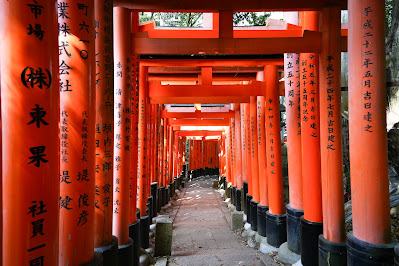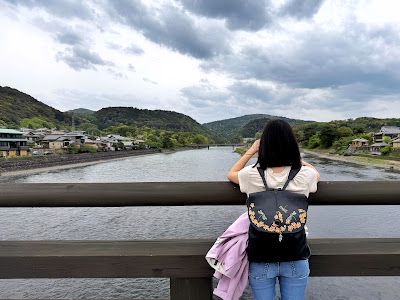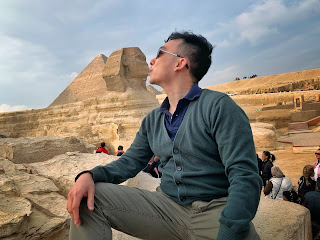 |
| Kyoto |
I thought it was an exaggeration to say that you can set a watch by Japan’s train schedule, but it’s true. We were meant to take the 10:34 train to Kyoto, and luckily, we didn’t board the train on our platform that left at 10:33. That train wasn’t our 10:34 train after all. The 10:34 train came by exactly on the dot and left within the minute.
Going to Masuya Saketen was one of the best thing that we had done. It’s an Izakaya, a sake bar much like a tapas bar. Every dish was delicious and thoughtfully crafted, and even a wild-sounding dish like mascarpone and tofu paste with strawberries and rape blossom was absolutely amazing. We ordered several plates to start with, and as the food started arriving and we realised how good they all were, we ordered more and more as we went along. Even their sashimi was on point, serving up slices of Bonito, a fish which I’d never eaten as sashimi before. It was a wonder how three people working in such an enclosed space could churn out fine-dining style dishes while handling front-of-house duties. We also had a couple of sake recommendations after speaking with them (fruity sake please!), who pointed us towards a couple of real winners. Both of the sakes were fruity as requested, and one of them (the Kagura) was from Matsui Brewery, which we’ll be touring later in Kyoto.
In a bit of serendipity, during our tour of Matsui Brewery a few days later, I asked the brewer for his sake bar recommendations and his first response was to go to Masuya Saketen. So he clearly had been just as impressed by this Izakaya as I was.
The crowd was mostly locals, but there’s an English menu for foreigners and the waitstaff have no issues communicating in English. We ordered two ‘go’ for the Kagura (each ‘go’ unit is 180ml), and the sake was served in a lovely conch-shaped tokkuri. For the second sake, I just ordered a single portion for myself, and watched the waitress deftly filled the sake cup and stopped right at the brink of overflowing. It was poetry in motion.
Hōkan-ji Temple's a five-storey pagoda, and visitors could climb to the second storey via steep wooden steps. There’s a traditional sweet shop (御菓子 艸堂 by The Sodoh Higashiyama Kyoto) nearby, in one of those blink-and-you-miss-it shopfronts. We got ourselves a daifuku and a pastry of azuki paste sandwiched between sweetened soft Japanese soufflés. We could sit in their wee courtyard overlooking the temple.
Kiyomizu-dera is a popular temple that takes a couple of hours to walk around the grounds. An additional section of the temple called the Zuigudo Hall is also worth visiting. In a spiritual journey called tainai meguri, visitors walk through an underground pitch-black walkway symbolising the spiritual realm. Pitch-black really meant pitch-black, as in no light at all, nada. I couldn’t see my own hand in front of me, and had to make my way through by feel.
Matsui brews and bottles unpasteurised sake (namazake, more specifically namachozo.) We were shown around brewery by Hiro-san, and after the tour, we could go around their bar/waiting room to taste the different sake products. The Kagura that we’d tried in Masuya Saketen was just one of several of their Kagura lines, with some bottles more fruity and rounded than others.
Perhaps the rarest sake, and the pricest, here was the 10-year namazake koshu, which was 1000 yen for each pour. It's quite a special brew: sake is generally meant to be drank young and do not benefit from ageing in the bottle. This goes double for namazake, which are unpasteurised and hence not shelf-stable. Ageing sakes to develop certain flavour profiles is a known style (koshu), but deliberately ageing an unpasteurised sake? That’s one extreme sake style. I had to have a taste. Like all namazake, this was fruity, surprisingly so, with none of the earthy profile that I expected from ageing. It was an eye-opening drink.
One morning, we got up early to go to Shirakawa Lane and to explore the temples of northeast Kyoto: the Okazaki Shrine, the Ōtoyo Shrine, the moss-covered grounds of Hōnenin Temple and Eikandō Temple. Our walk brought us through Okazaki Park, where cherry blossoms still bloomed, and through a serene stretch of road known as the Tetsugaku No Michi (The Philosopher's Walk). It was a peaceful walk in the cool spring air, and there were a few other people with the same idea. Some were walking their dogs, a couple of old men were sketching next to the canal and along one stretch of road, a man was sitting cross-legged on the pavement while playing a large tongue drum.
It's not just cherry blossoms that we can see; mid-April also marks the start of Wisteria season. And in another point in favour of being here in spring: strawberry season runs from December to May.
 |
| Strawberry sandwich for breakfast. There were more strawberries in the sandwich than what the cynic in me suspected. |
We came to Arashiyama Bamboo Forest on one very early morning. It was drizzling as we exited the station, but neither the wee hours or the rain seemed to have affected the crowd size.
We reached around 7 in the morning, but the bamboo forest was already quite packed. In fact, some people were already coming out of the forest as we went in. Luckily, along some stretches of the path, the crowd thinned out just enough to snap a quick photo or two.
We had delightful meals in Kyoto, even on an occasion when we bought sushi and sashimi from the supermarket. I was shocked by the prices: a whole tray of uni for 1500 yen apiece? A sashimi bowl of salmon roe and scallops for 1000 yen? We bought all of the above, along trays upon trays of sweet shrimps and thickly cut tuna. One of our favourite things to do in Japan is also to explore the basement of departmental stores such as Takashimaya, where there are also a lot of fine Japanese patisserie to purchase for an after-dinner snack.
Of course, we spent time exploring the food scene. We had delicious gyukatsu from the chain Gyukatsu Kyoto Katsugyu near Kyoto Station, where we alighted after visiting Arashiyama. Each steak is breaded and fried, and then patrons can further cook each wedge of beef on a tabletop fire to desired doneness.
One of the really nice meals that we came across serendipitously was a wonderful ramen shop called Nandattei near Gion. We were actually on our way to another ramen shop, but as we walked past Nandattei and noticed a queue forming before its opening hours, we quickly joined the queue. Service was quick, and we tucked into rich hot broths of tomato curry ramen. It’s a flavour combination that sounds a bit wild, but the flavours melded beautifully. We smelled of delicious ramen as we left.
Another ramen joint serving wonderful bowls of ramen was Wajoryomen Sugari. Google Maps will bring you to the right place, even though the shopfront sign didn't spell out the English name. The smell smell emanating from their stock pots (and the subsequent taste) proved that we were in the right place. The broth was made from fish, and each spoonful was deeply flavourful. It was one of the best ramen places that we went to.
We had one of our most memorable meals at a sushi place near Gion that we stumbled upon. Tomi Sushi was in the same area as Nandattei, and we came across it on one of those days when we set off for dinner just a little too late and our shortlisted restaurants were already full. This restaurant’s a small sushi bar with mainly countertop seating. It honestly was quite packed as well, but it had a couple of empty seats. We walked in and found that it caters to a very local crowd (we were the only non-Japanese folks there). There was definitely a bit of hesitation when the staff realised that we didn’t know Japanese, but the staff knew a smattering of English.
The two of us got through dinner with some ‘osusume onegaishitmasu’ (recommendations please), and a lot of pointing at the menu. The sushi were made to order, the sashimi was as fresh as they come, and the prices were reasonable. I tried a ‘gochisousama deshita’ at the end, but that was harder for me and I’m pretty sure I stumbled over the words. Despite our non-existent Japanese, they were nothing but friendly and outwardly gracious, and everybody - the servers, the sushi chef, and even a fellow elderly customer sitting next to us - did everything they could to engage us in conversation throughout dinner and make us feel welcome. It was a terrific experience.
 |
| Just take a look at the rice-to-topping ratio! |
A recent survey of tourists in Japan indicated that one of their main frustrations was that the Japanese isn’t proficient in English and this had caused the tourists inconvenience. I don’t know what sort of tourists they're surveying, but that’s not how being a tourist usually works. It seemed a bit ludicrous to go to a foreign country, not bother to learn their language and instead expect them to speak yours. The average Japanese’s English is probably far better than the average tourist’s Japanese. The barriers to communications were real, but it was more of a cause for embarrassment for myself for not knowing their language, rather than to feedback that the locals should speak the language of tourists. Did it help with my Tomi Sushi experience that I knew a grand total of 3 short Japanese phrases? I didn’t think that it helped us to get seated, though I certainly felt better about myself for knowing - or at least tried to learn - a few phrases. I probably mangled the pronunciation as well; languages and me don’t mix very well together. But it doesn’t take much effort to at least learn a few phrases beforehand. And the sheer audacity to go to Japan and complain that the locals are not proficient in (insert your native language here)? So silly. But anyway, I digress.
Fushimi and Uji are doable day trips from Kyoto, and we had fun exploring these areas via a 1 day sightseeing pass for Kyoto courtesy of Klook. This pass covers traveling between Kyoto city, Fushimi and Uji.
Our first stop was Fushimi Inari Shrine, an immensely attraction for its sheer numbers of Tori gates along the winding path. It was a moderately strenuous climb to the peak, about 1.5-2 hours in total, but there were several rest stops along the way, including two teahouses. It was still insanely crowded even when we tried to come early. Because we were so early that the next attraction wasn't going to be open for the next few hours, we walked to the top. The crowd thinned the further we climbed, and we could get some nice portrait shots from about midway up.
A few train stations away is Fushimi Sake Village, which is located in a quiet lovely neighbourhood. It’s the sake equivalent of a beer hall, and you can order drinks to go along with dishes from several of the food stalls in the restaurant. There are a couple of Japanese in here and a lot of tourists. Everybody had the sake flight in front of them (18 shots from 18 breweries!).
We came to Uji after lunch, the matcha mecca. We spent a pleasant hour at the Horhi Shichimeien tea shop. The shop attendants were busy when walked in, but during a lull period as earlier customers left, we were invited to sit at the table where they brewed cups of their ceremonial-grade matcha for us.
We were sold on the matcha, but there was a catch: due to severe matcha shortages, the store had a policy that each person could only purchase no more than two bags of ceremonial matcha, and their top grade matcha was limited to one per person. It was disappointing, but in a uniquely-Japanese egalitarian fashion.
While in Uji, we visited the Byodo-in Temple, a Buddhist temple designated as a UNESCO World Heritage Site. Its likeness is stamped on the back on every 10 yen coin. The ticket office staff kindly broke down one of my larger notes so I could hold up a 10 yen coin in front of the temple.
Like some of the larger major temples, Byodo-in Temple has a Goshuin station, where you can mark a page of your Goshiun notebook with its calligraphy and an official stamp of the temple.
Afterwards, we had a pleasant time sitting at Nakamura Tokichi Byodo-in for matcha drinks and parfaits next to the river.
There's plenty to see and do in Kyoto, but the advice I got was to take it easy and enjoy each moment instead of ticking every temple off a checklist. We spent 5 lovely days in Kyoto, and had a terrific stay in Sora Niwa Hotel. It’s near Gion, close to all the delicious restaurants, and even better, there are pre-dinner cocktail drinks on the rooftop and a full traditional onsen experience. It was simply the perfect Kyoto experience that we were looking for (yes. Even for someone like me who came in expecting a 1900s-era Kyoto.)
Recent Japan Travels:
Osaka in Spring 2025: Osaka City (Part 1)
Osaka in Spring 2025: Kyoto and Uji (Part 2)
Osaka in Spring 2025: Hida-Takayama and Shirakawa-Go (Part 3)
Osaka in Spring 2025: Toyama and the Alpine Trail (Part 4)
Osaka in Spring 2025: Matsumoto, Nagano: (Part 5)



















































Wow what a Great Information about World Day its very nice informative post. thanks for the post.Togel Online
ReplyDelete